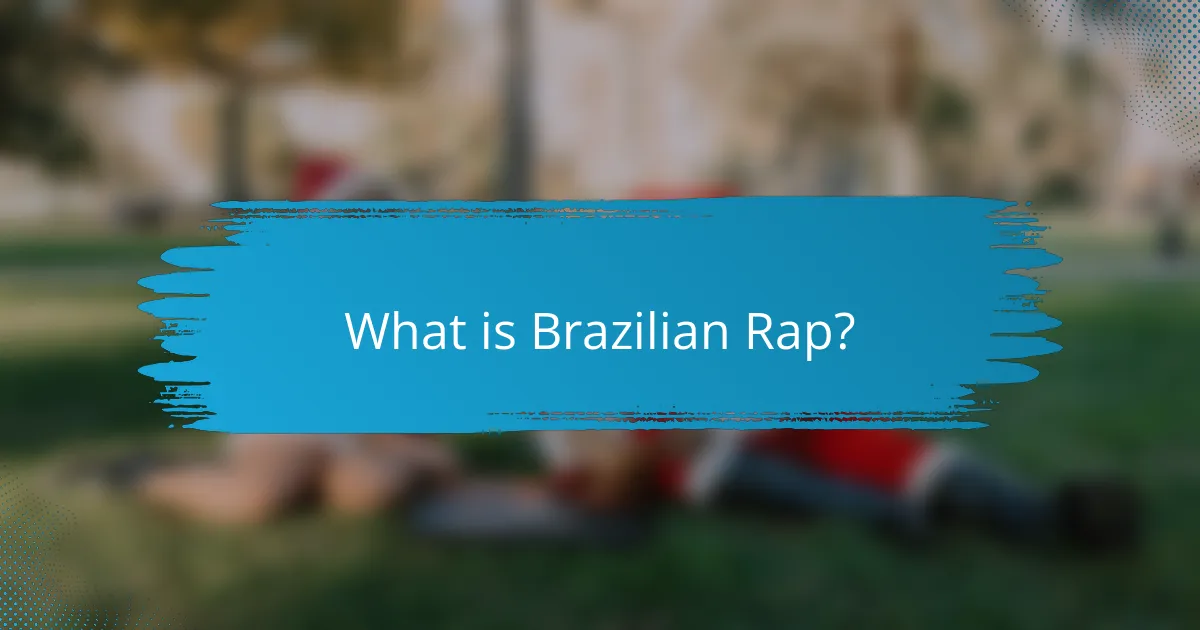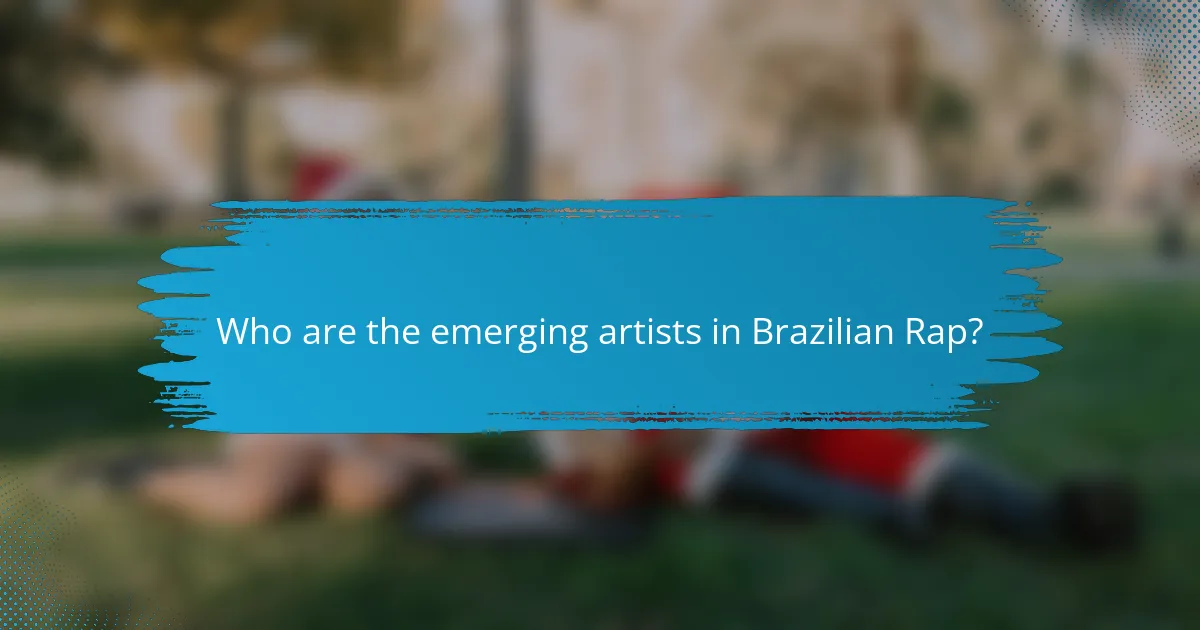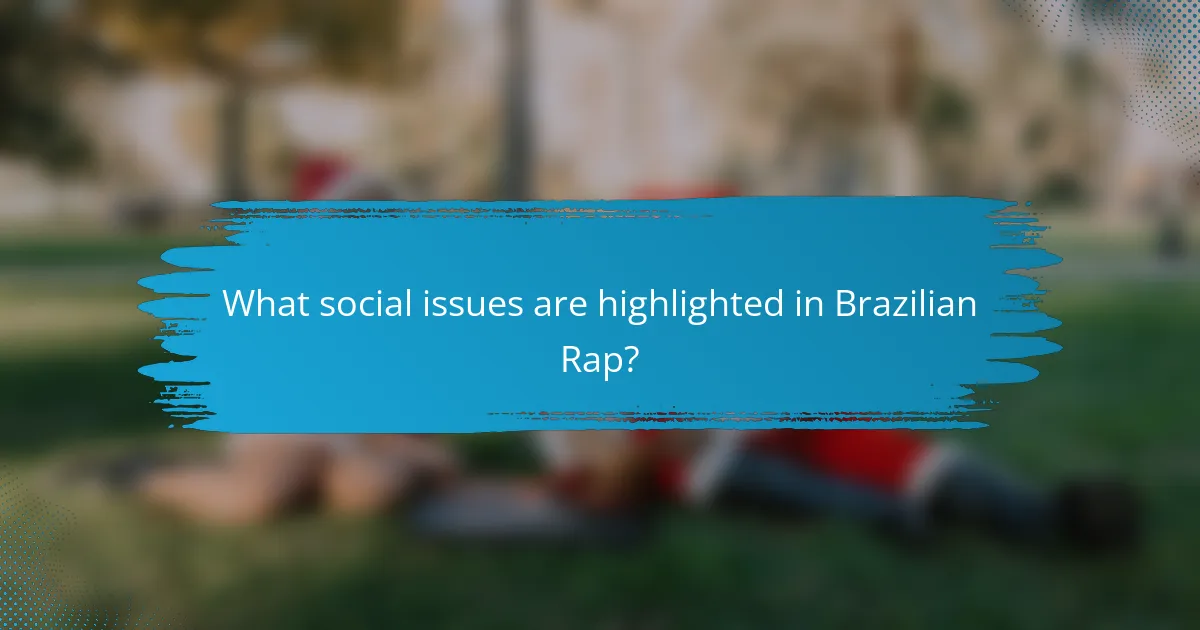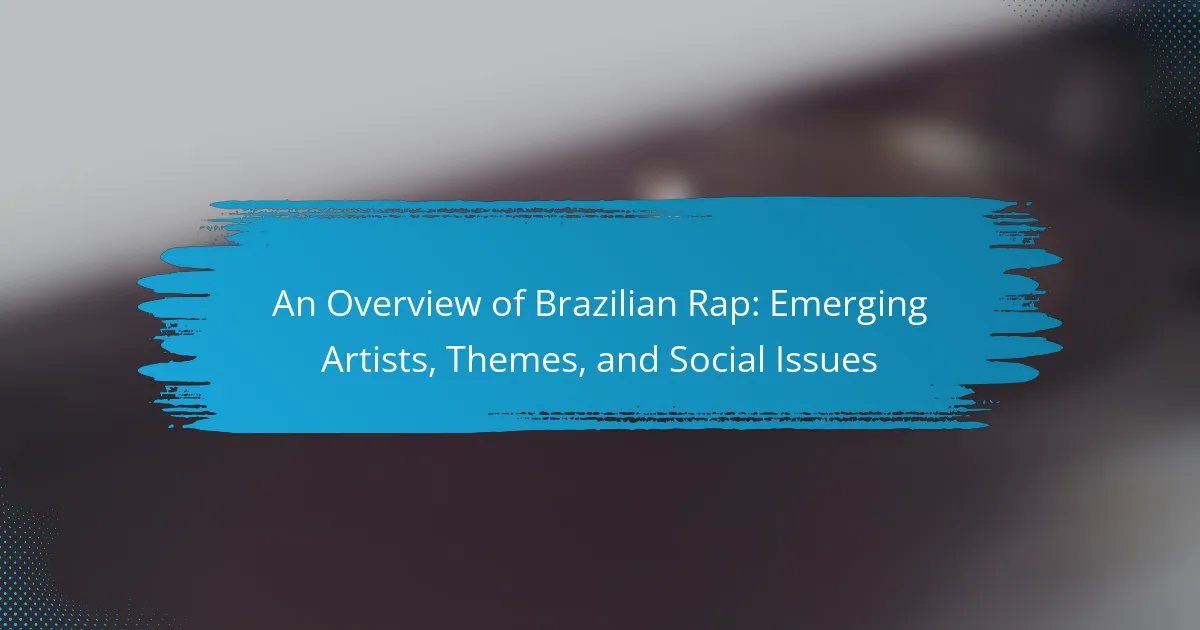Brazilian Rap is a musical genre that originated in Brazil, influenced by American hip-hop, and characterized by its use of rhythm and poetry to address social issues, cultural identity, and personal experiences. Emerging in the late 1980s and gaining prominence in the 1990s, the genre features artists who often use Portuguese lyrics to convey their messages, reflecting the realities of urban life, particularly in favelas. Notable artists include Racionais MC’s and MV Bill, while newer talents like Baco Exu do Blues, Rico Dalasam, and Tasha & Tracie are shaping the genre’s future with their unique styles. Brazilian Rap addresses critical themes such as poverty, violence, racism, and inequality, serving as a powerful voice for marginalized communities and a tool for social commentary and activism.

What is Brazilian Rap?
Brazilian Rap is a musical genre that originated in Brazil, heavily influenced by American hip-hop. It combines rhythm and poetry to address social issues, cultural identity, and personal experiences. The genre emerged in the late 1980s and gained popularity in the 1990s. Artists often use Portuguese lyrics to express their messages. Brazilian Rap reflects the realities of urban life, particularly in favelas. Notable artists include Racionais MC’s and MV Bill. The genre has evolved, incorporating various styles like funk and samba. Brazilian Rap serves as a voice for marginalized communities, highlighting their struggles and aspirations.
How did Brazilian Rap emerge as a genre?
Brazilian Rap emerged as a genre in the late 1980s. It was influenced by the global hip-hop movement, particularly from the United States. Early Brazilian rappers began to incorporate local themes and Portuguese lyrics. The genre gained popularity in urban areas, especially in São Paulo and Rio de Janeiro. It addressed social issues like poverty, violence, and inequality. Key figures like Racionais MC’s and MV Bill played a significant role in its development. They used their music to voice the struggles of marginalized communities. By the 1990s, Brazilian Rap had established a distinct identity within the broader hip-hop culture.
What historical and cultural influences shaped Brazilian Rap?
Brazilian Rap is shaped by diverse historical and cultural influences. The roots of Brazilian Rap trace back to the African diaspora and the struggles against social inequality. Influences from samba and bossa nova also play a significant role in its development. The 1980s and 1990s saw the emergence of hip-hop culture in Brazil, inspired by American rap. Political movements and social issues further fueled its growth, addressing topics like poverty and violence. The cultural landscape of Brazilian Rap is enriched by local dialects and regional styles. Artists often draw from their personal experiences, reflecting the realities of urban life. This blend of influences creates a unique expression of identity and resistance in Brazilian Rap.
How has Brazilian Rap evolved over the years?
Brazilian Rap has evolved significantly since its inception in the late 1980s. Initially, it emerged as a form of expression for marginalized communities in Brazil. The genre was heavily influenced by American hip-hop, incorporating local rhythms and Portuguese lyrics. In the 1990s, artists like Racionais MC’s brought attention to social issues such as racism and poverty. The 2000s saw the rise of new subgenres, including funk carioca, blending rap with electronic beats. By the 2010s, Brazilian Rap gained international recognition, with artists collaborating globally. Today, the genre continues to address contemporary social issues, reflecting the changing dynamics of Brazilian society.
What are the key characteristics of Brazilian Rap?
Brazilian Rap is characterized by its unique lyrical content, rhythmic style, and cultural influences. The lyrics often address social issues, including poverty, violence, and inequality. This genre reflects the realities of life in Brazilian favelas. The beats typically incorporate elements of samba, funk carioca, and electronic music. Brazilian Rap artists often use a conversational and direct approach in their delivery. The genre promotes a strong sense of community and identity among its listeners. Notable artists, such as Racionais MC’s and Criolo, have gained recognition for their impactful messages. The movement has also seen a rise in female artists, expanding the diversity within the genre.
What themes are commonly explored in Brazilian Rap lyrics?
Common themes in Brazilian Rap lyrics include social inequality, violence, and identity. Many artists address the struggles faced by marginalized communities. They often highlight systemic issues such as poverty and police brutality. Additionally, themes of resilience and empowerment are prevalent. Artists use their lyrics to express cultural pride and personal experiences. The genre serves as a voice for the youth in urban areas. It reflects the realities of life in favelas and urban centers. Brazilian Rap also engages with political commentary and activism. This makes it a powerful medium for social change.
How does the musical style of Brazilian Rap differ from other genres?
Brazilian Rap is characterized by its unique blend of local cultural influences and social commentary. It often incorporates elements of samba, bossa nova, and funk carioca, setting it apart from other rap genres. The lyrics frequently address social issues, inequality, and urban life in Brazil, providing a distinct narrative style. Unlike mainstream hip-hop, Brazilian Rap emphasizes regional dialects and rhythms, creating a localized sound.
For example, artists like Racionais MC’s and Criolo utilize their music to reflect the struggles of marginalized communities. This focus on socio-political themes is a defining feature that differentiates it from other rap styles. Furthermore, the use of Brazilian Portuguese adds to its uniqueness, making the lyrical content resonate deeply with local audiences.

Who are the emerging artists in Brazilian Rap?
Emerging artists in Brazilian Rap include artists like Baco Exu do Blues, Rico Dalasam, and Tasha & Tracie. Baco Exu do Blues gained recognition for his innovative sound and impactful lyrics. Rico Dalasam is known for addressing social issues and identity in his music. Tasha & Tracie, a duo, blend rap with feminist themes and empowerment messages. These artists are shaping the future of Brazilian Rap with their unique styles and perspectives. Their growing popularity reflects the vibrant evolution of the genre in Brazil.
Which new artists are gaining recognition in the Brazilian Rap scene?
New artists gaining recognition in the Brazilian Rap scene include Matuê, Tasha & Tracie, and Orochi. Matuê has gained popularity with hits like “Kenny G,” showcasing a unique blend of rap and melodic elements. Tasha & Tracie are notable for their empowering lyrics and strong female presence in a male-dominated genre. Orochi has made waves with his distinctive style and viral tracks, appealing to a younger audience. These artists reflect the evolving landscape of Brazilian Rap, addressing contemporary social issues and personal narratives. Their growing fanbases and streaming success indicate their rising influence in the music industry.
What unique styles do these emerging artists bring to the genre?
Emerging Brazilian rap artists bring diverse styles to the genre. They often blend traditional Brazilian rhythms with contemporary hip-hop beats. This fusion creates a unique sound that resonates with local culture. Many artists incorporate regional dialects and slang into their lyrics. This adds authenticity and connects with their audience. Some artists focus on socially conscious themes, addressing issues like inequality and violence. Others experiment with melodic elements, incorporating singing into their verses. This variety enriches the genre and attracts a broader audience. The innovative approaches of these artists are reshaping Brazilian rap’s landscape.
How are these artists addressing social issues through their music?
Brazilian rap artists address social issues through their lyrics and performances. They often highlight themes such as poverty, violence, and inequality. For instance, artists like Emicida and Criolo use their platforms to discuss systemic racism and social injustice. Their music reflects the struggles of marginalized communities. By sharing personal stories, they create a connection with listeners. This approach raises awareness and encourages dialogue about pressing societal challenges. Their work has led to increased visibility for social issues in Brazil. Furthermore, collaborations with activists amplify their messages. This fusion of art and activism fosters community engagement and inspires change.
What challenges do emerging Brazilian Rap artists face?
Emerging Brazilian Rap artists face significant challenges including limited access to funding and resources. Many struggle to secure financial backing for their projects. This lack of funding affects their ability to produce high-quality music. Additionally, competition in the music industry is fierce. Numerous artists vie for attention in a saturated market.
Cultural barriers also pose challenges. Artists often confront societal stereotypes and biases against their music genre. Moreover, there are difficulties in gaining mainstream media exposure. Traditional media outlets may overlook emerging talent in favor of established artists.
Legal issues can arise regarding copyright and music distribution. Many artists lack knowledge about their rights and protections. Furthermore, navigating the digital landscape can be complex. Artists must effectively use social media and streaming platforms to reach audiences.
Economic disparities in Brazil further complicate their journey. Many aspiring artists come from underprivileged backgrounds. This limits their opportunities for professional growth and networking. Overall, these challenges hinder the potential success of emerging Brazilian Rap artists.
How do economic factors impact the careers of these artists?
Economic factors significantly impact the careers of Brazilian rap artists. Limited financial resources can restrict access to production quality and marketing opportunities. Artists from lower socioeconomic backgrounds may struggle to gain visibility in a competitive industry. Economic downturns can reduce funding for cultural initiatives, affecting artist support. Conversely, a growing economy may increase investment in the arts, benefiting artists. For example, the rise of digital platforms has allowed some artists to monetize their work independently. Statistics show that economic growth correlates with increased opportunities for emerging artists. Understanding these dynamics is crucial for analyzing the evolution of Brazilian rap.
What role does social media play in their rise to fame?
Social media plays a crucial role in the rise to fame of Brazilian rap artists. It serves as a platform for artists to showcase their music and connect with fans directly. Many emerging artists utilize social media to share their work without the need for traditional music industry gatekeepers. This democratization allows for a diverse range of voices and styles to be heard. Statistics show that platforms like Instagram and YouTube have millions of active users in Brazil, providing significant exposure. Viral challenges and trends on these platforms often propel songs to popularity quickly. Additionally, social media facilitates collaborations among artists, further expanding their reach. Overall, social media is integral to the contemporary success of Brazilian rap artists.

What social issues are highlighted in Brazilian Rap?
Brazilian Rap highlights various social issues, including poverty, violence, racism, and inequality. The genre often reflects the struggles of marginalized communities. Artists use their lyrics to address systemic injustices faced by these groups. For instance, many songs discuss police brutality and the impact of drug trafficking. Additionally, racism is a recurring theme, showcasing the discrimination faced by Black Brazilians. The genre serves as a voice for the youth, expressing their frustrations and aspirations. Its roots in the favelas emphasize the socio-economic disparities in Brazil. Brazilian Rap has become a powerful tool for social commentary and activism.
How does Brazilian Rap reflect societal challenges?
Brazilian Rap reflects societal challenges by addressing issues like poverty, violence, and inequality. The genre originated in marginalized communities. It serves as a voice for the disenfranchised. Artists often share personal stories of struggle and resilience. Lyrics frequently critique government policies and social injustices. For example, songs highlight police brutality and systemic racism. Brazilian Rap also raises awareness about education and health disparities. This connection to real-life experiences makes the genre impactful and relatable.
What specific social issues are frequently addressed in the lyrics?
Brazilian rap frequently addresses social issues such as poverty, violence, and inequality. Lyrics often reflect the struggles of marginalized communities. Artists use their platform to highlight systemic issues affecting their neighborhoods. Themes of police brutality and social injustice are prevalent in many songs. Mental health awareness is also increasingly represented in the lyrics. Gender inequality and the empowerment of women are critical topics as well. Environmental concerns and urban living conditions are addressed by some artists. These themes resonate deeply with listeners and provoke social awareness and dialogue.
How do artists use their platform to advocate for change?
Artists use their platform to advocate for change by addressing social issues through their music and performances. Brazilian rap artists often highlight themes such as inequality, violence, and systemic oppression. They use lyrics to tell personal stories and reflect community struggles. This approach fosters awareness and encourages dialogue among listeners. For example, artists like Emicida and Racionais MC’s have gained recognition for their poignant commentary on social injustices. Their music resonates with audiences and inspires activism. Additionally, many artists engage in community initiatives and collaborations with NGOs. This further amplifies their message and impact on societal change.
What impact does Brazilian Rap have on society?
Brazilian Rap significantly impacts society by addressing social issues and empowering marginalized communities. It serves as a voice for the youth, expressing their struggles and aspirations. The genre reflects the realities of poverty, violence, and inequality in Brazil. Artists like Racionais MC’s and Emicida highlight these themes in their lyrics. This form of music fosters a sense of identity and unity among listeners. It also encourages political awareness and activism. Studies show that Brazilian Rap influences public discourse on social justice. Overall, it plays a crucial role in shaping cultural and social narratives in Brazil.
How does Brazilian Rap influence public perception of social issues?
Brazilian Rap significantly influences public perception of social issues by highlighting inequalities and injustices. The genre serves as a voice for marginalized communities. Artists often address topics such as poverty, violence, and racism in their lyrics. This exposure raises awareness among listeners about these pressing issues. Research indicates that rap music can shape social attitudes and encourage activism. According to a study by R. S. Silva in “Cultural Sociology,” rap music in Brazil has increased public discourse surrounding social justice. This impact is evident in the way listeners relate to the struggles portrayed in the songs. Consequently, Brazilian Rap plays a crucial role in shaping societal views on critical social matters.
What role does community engagement play in the movement?
Community engagement is crucial in the Brazilian rap movement. It fosters a sense of belonging among artists and audiences. Engaged communities amplify voices that address social issues. They create platforms for dialogue about inequality and injustice. Participation in local events builds solidarity and support. Collaborative projects enhance creativity and cultural expression. Research shows that community involvement leads to increased awareness of social issues. This engagement drives the movement’s relevance and impact in society.
What can listeners learn from Brazilian Rap?
Listeners can learn about social issues and cultural identity through Brazilian Rap. The genre often addresses themes such as poverty, violence, and inequality. Artists use their lyrics to reflect personal and communal struggles. This provides insight into the realities faced by marginalized communities in Brazil. Additionally, Brazilian Rap promotes resilience and hope. It showcases the power of music as a form of expression and resistance. By engaging with these themes, listeners gain a deeper understanding of Brazilian society. The genre also highlights the rich cultural heritage of Brazil, blending influences from various musical styles. Overall, Brazilian Rap serves as an important educational tool for understanding complex social dynamics.
How can understanding the themes in Brazilian Rap foster empathy?
Understanding the themes in Brazilian Rap can foster empathy by highlighting social issues and personal struggles. The lyrics often address poverty, violence, and discrimination faced by marginalized communities. This portrayal allows listeners to connect emotionally with the experiences of others. For instance, artists like Racionais MC’s and Criolo share stories from their lives, making the struggles relatable. Such narratives can challenge stereotypes and promote understanding among different social groups. Research shows that exposure to diverse perspectives can enhance empathy, making Brazilian Rap a powerful tool for social awareness.
What resources are available for exploring Brazilian Rap further?
Key resources for exploring Brazilian Rap include academic journals, music streaming platforms, and documentaries. Academic journals such as “Brazilian Journal of Musicology” provide scholarly articles on the genre. Music streaming platforms like Spotify and Apple Music feature curated playlists of Brazilian Rap artists. Documentaries such as “Brega Stereophonic” and “Funk: O Filme” offer insights into the cultural context of the music. Additionally, books like “Raps e Rimas: A História do Rap no Brasil” by André A. de Almeida explore the genre’s history and evolution. Online forums and social media groups also serve as platforms for discussion and discovery of new artists. These resources collectively enhance understanding of Brazilian Rap’s themes and social issues.
Brazilian Rap is a musical genre that originated in Brazil, influenced by American hip-hop, and addresses social issues, cultural identity, and personal experiences. The article provides an overview of the genre’s emergence in the late 1980s, its evolution, and key characteristics, including its unique lyrical content and cultural influences. It highlights notable artists and emerging talent, explores common themes such as inequality and violence, and discusses the impact of Brazilian Rap on society and public perception of social issues. Additionally, the article examines the challenges faced by artists and the role of community engagement and social media in the genre’s development.
